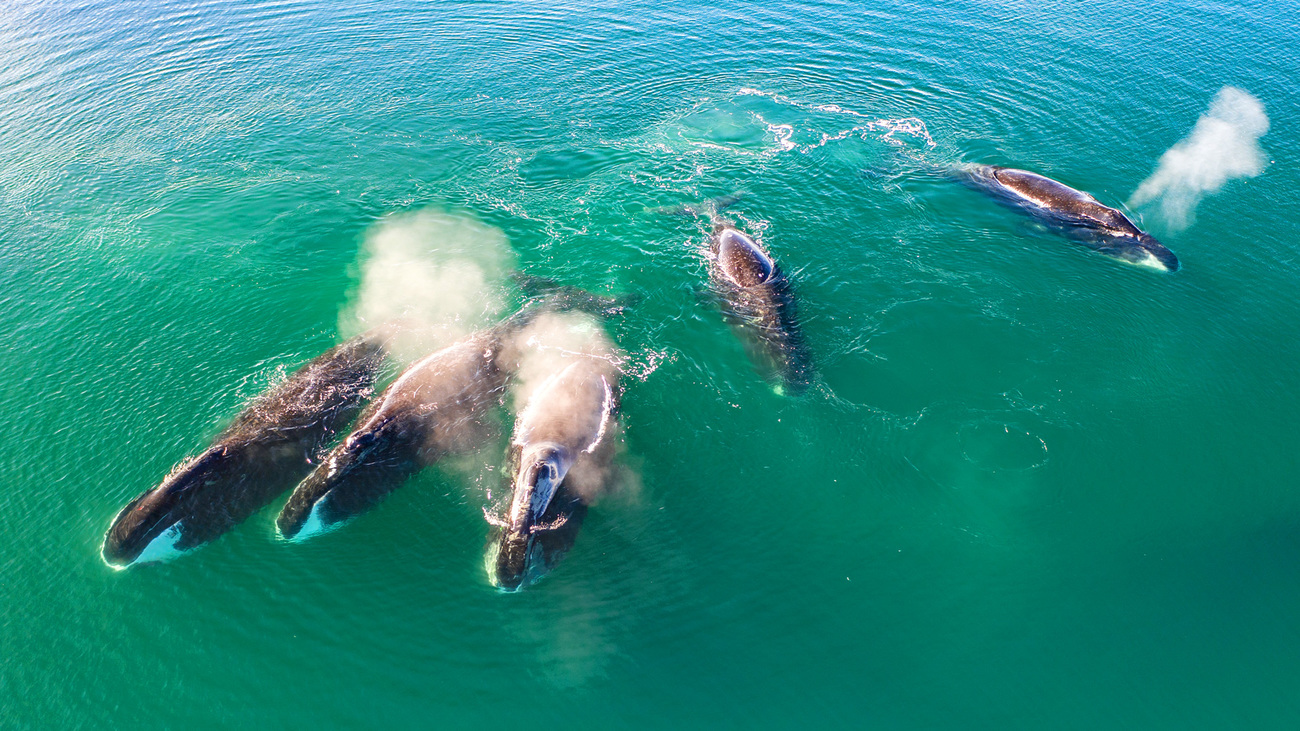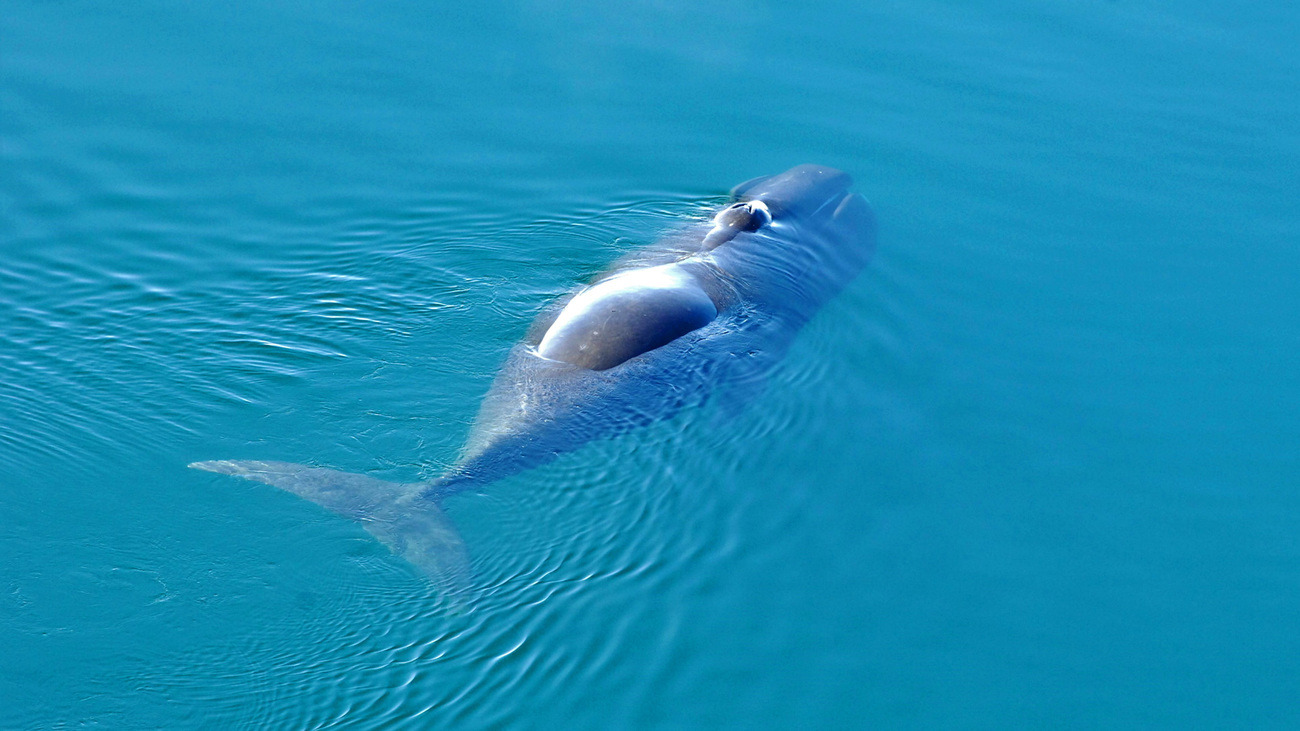Bowhead whales
Bowhead whales inhabit the cold and icy waters of the Arctic and subarctic regions. These majestic giants are one of the largest whale species, second only to the blue whale. They can grow to lengths of up to 20 meters and weigh anywhere between 75 and 100 tonnes.
The name ‘bowhead’ is attributed to their distinctively large, bow-shaped heads, which can account for up to 40% of their entire body length. The insides of a bowhead whale’s jaws are lined with around 300 baleen plates, with each plate measuring up to 4 meters long. These baleen plates allow bowhead whales to trap zooplankton, particularly copepods and krill, while expelling water. It’s a highly efficient feeding process that allows them to consume large quantities of prey during the summer months, when the Arctic waters are flourishing with life.
Bowhead whales are known for their slow and deliberate yet powerful movements. Using their strong heads and bodies, they are capable of breaking through sea ice at least 18 centimeters thick. Bowheads are also skilled divers, reaching depths of up to 400 meters. They’re solitary creatures that tend to live in smaller groups, although they may gather in larger pods during migration and for feeding.
Compared to other whale species, bowheads have a relatively slow reproductive rate. They reach sexual maturity at 25 years old and, although they have been observed to mate throughout the year, most conceptions occur towards the end of winter or during spring. Female bowheads have a gestation period of 13 to 14 months and will typically birth a calf every 3 to 4 years. Most calves are born during spring migration and are about 4 meters long, weighing around 1000 kilograms. Bowhead calves are able to swim from birth and are nurtured by their mothers. Mother-calf pairs form strong bonds that are crucial to the calves’ survival in the challenging Arctic environment.
Bowhead whales play a critical role in maintaining the balance of their Arctic ecosystems. Sitting at the top of the food chain, they’re key to regulating the population of their zooplankton prey. This affects the entire food web, especially the other creatures that also rely on zooplankton as a food source, including fish and birds. By feeding on zooplankton, bowheads also indirectly contribute to carbon sequestration. It keeps their population in balance to prevent overfeeding on phytoplankton, a plankton that absorbs atmospheric carbon dioxide and consequently plays an important role in mitigating climate change.
The bowhead whale is also referred to as the right whale, which alludes to their history as a hunted animal. Between the 17th and 19th centuries, bowheads were hunted for their oil, meat and baleen, which form strong and elastic materials. They got the name right whale because they were the ‘right whale’ to hunt for financial gain.
Today, bowhead whales still face many threats, including the effects of climate change and habitat loss to toxins, entanglement with fishing nets, and vessel strikes. It’s vital that we work to safeguard these majestic and vital creatures.
To learn more about these fascinating animals, let’s explore some key bowhead whale facts.
What is a bowhead whale’s scientific name?
The scientific name for a bowhead whale is Balaena mysticetus. They are also known as right whales, Greenland right whales, or Arctic whales.
Are bowhead whales endangered?
Thanks to conservation efforts, the bowhead whale is not currently endangered. Its conservation status is listed on the IUCN Red List as ‘least concern’ overall, though some subpopulations in specific regions (such as near Greenland) are endangered.
Bowheads were targeted by hunters for centuries for their oil, meat, and baleen, initially by indigenous communities in the Arctic and subsequently for commercial exploitation. This drove down their populations until international conventions were implemented in the 1930s to ban the commercial whaling of bowhead whales.
Since these conservation measures were put in place, the BCB (Bering-Chukchi-Beaufort) subpopulation of bowhead whales has been making a remarkable recovery, with their numbers steadily increasing at an approximate rate of 3% annually. As of the latest estimates, this particular subpopulation is believed to consist of around 10,000 individuals, reflecting the effectiveness of international efforts to protect and conserve these remarkable marine mammals.
Where do bowhead whales live?
Bowhead whales are primarily found in the Arctic ocean, including the Beaufort Sea, Chukchi Sea, Bering Sea, and the waters around the Canadian Arctic Archipelago. They have a circumpolar distribution, which means they inhabit the northernmost waters around the Arctic Circle. They’re also known to inhabit Baffin Bay, Hudson Bay, the Sea of Okhotsk, and the Davis Strait.
Threats
Bowhead whales face several threats. While they have rebounded in numbers following protective measures against commercial whaling, several modern-day challenges, including entanglement in fishing gear, water contaminants, ocean noise, vessel strikes, and predation, continue to jeopardize their populations.

Entanglement in fishing gear
Bowhead whales often unintentionally get caught in nets, lines, and other fishing gear, particularly in regions where commercial and subsistence fishing cross with their migration routes. This can lead to injury (around 12% of whales found in the Western Arctic have scars caused by entanglement in fishing gear) and even death if the whales are unable to free themselves.
Contaminants
The Arctic waters are contaminated by municipal wastewater discharges, ocean spills, runoff, and deposits from air contaminants, as well as discharges from fishing, shipping, oil- and gas- related commercial activities, and more. These pollutants can accumulate in the whales’ blubber and tissues over time, affecting their health and reproductive success. As animals with long lives and slow reproductive rates, bowheads are particularly vulnerable to the bioaccumulation of toxins.
Ocean noise
Increasing levels of ocean noise from various human activities, such as shipping and industrial operations, can disrupt bowhead whales’ communication and navigation. These cetaceans rely on sound for vital activities like finding food and mates. Prolonged exposure to loud noise pollution can stress and disorient them, impacting their ability to thrive in their natural environment. Noise pollution is also thought to negatively impact their prey, reducing the amount of food available to bowhead whales.
Vessel strikes
Collisions with vessels, including large ships and smaller boats, can be fatal for bowhead whales. As shipping traffic in Arctic waters increases due to melting ice and expanded economic activities, the risk of vessel strikes rises.
Predation
Despite their enormous size, bowhead whales can still fall prey to natural predators. Orcas, also known as killer whales, occasionally hunt bowhead calves or weakened individuals. Scars that are consistent with that of a killer whale attack have been found on around 8% of whales that were hunted and have continued to increase over time. The predation risk, though natural, may become more pronounced if environmental changes alter the distribution and behavior of both bowhead whales and their predators.
FAQs
How long do bowhead whales live?
While the lifespan of bowhead whales isn’t known precisely, they can live well over 100 years, with some studies even suggesting that they can live up to 200 years. It’s thought that these longer lifespans are owed to a gene they carry that can repair damaged DNA.
Can a bowhead whale live up to 200 years?
With recent developments in the techniques used to determine the age of bowhead whales, it is thought that they can live up to 200 years old.
What do bowhead whales eat?
The core part of a bowhead whale’s diet is zooplankton, specifically copepods and krill, among other smaller organisms in their ocean habitat. They’re filter feeders, meaning that they capture their prey by filtering them in from the surrounding water.
They feed by opening their vast mouths to engulf a significant volume of water containing plankton and other small organisms. They then close their mouths, using their tongues to push the water out through baleen plates—comb-like structures made of keratin that trap the zooplankton while expelling water through their mouths. Once the water has been expelled, they swallow their captured prey.
Are bowhead whales carnivores?
Bowheads are carnivores that feed almost exclusively on marine invertebrates, primarily zooplankton.
What does a bowhead whale look like?
Bowhead whales have robust bodies with large, round backs, no dorsal fin, and a thick layer of blubber to keep them warm. As their name suggests, bowheads have huge, bow-shaped heads with arched upper jaws. They also have large flippers, as well as a pair of blowholes on the tops of their heads, which they use to breathe. They are dark grey to black colored, sometimes with pale patches near their tails.

How long is a bowhead whale?
The average adult bowhead whale will grow up to 20 meters long.
How big is a bowhead whale?
A bowhead whale is the second largest whale, just behind the blue whale. They can weigh up to 100 tonnes and have a 49-centimeter-wide layer of blubber, helping to keep them warm in the frigid Arctic Ocean.
Are bowhead whales extinct?
Bowhead whales are not extinct. While they were heavily hunted by both indigenous peoples and commercial whalers in the past (which significantly reduced their populations) their conservation status is now ‘least concern’. This is thanks to international conservation efforts and the banning of commercial whaling, which helped their populations slowly recover.
How many bowhead whales are left in the world?
The IUCN Red List estimates that there are around 10,000 mature bowhead whales left in the world, and their population is increasing.
Our work
Through our work to reduce underwater noise pollution and the risk of collisions with ships and other vessels, IFAW is working to safeguard the populations of bowhead whales to ensure their survival.
Sonic Sea, a poignant, 60-minute documentary by Imaginary Forces and the Natural Resources Defense Council (NRDC) in association with IFAW, sheds light on the detrimental consequences of increasing industrial and military ocean noise on marine life, particularly whales. With narration by Rachel McAdams and a feature from Sting, the film not only highlights the challenges but also presents solutions and optimism for a quieter ocean. It underlines that, unlike other pollutants, ocean noise can be swiftly eradicated once its sources are eliminated. Global scientific communities and authorities like NOAA, the EU, and the IMO have been advocating for noise reduction, while industry-specific noise-quieting technologies are emerging. The film calls for political commitment to implement these solutions and urges individuals to learn more about the issue and support efforts to reduce ocean noise pollution across the globe. Sonic Sea received three Emmy Award nominations in 2017.
IFAW’s Blue Speeds campaign similarly promotes action to make our ocean quieter, safer, and healthier for whales, including the bowhead whale. Elevated ship speeds are a major cause of underwater noise pollution in the ocean, which causes stress and disturbance and interferes with critical whale behaviors as well as the behavior of other marine life. By slowing ship speeds, we can help to create a safer and quieter home for whales and all marine animals.
How can you help?
Bowhead whales face threats of entanglement, vessel strikes, and ocean noise pollution. IFAW works tirelessly to combat these issues. If you would like to contribute to efforts to protect and safeguard bowhead whales, you can donate to IFAW’s dedicated team.
